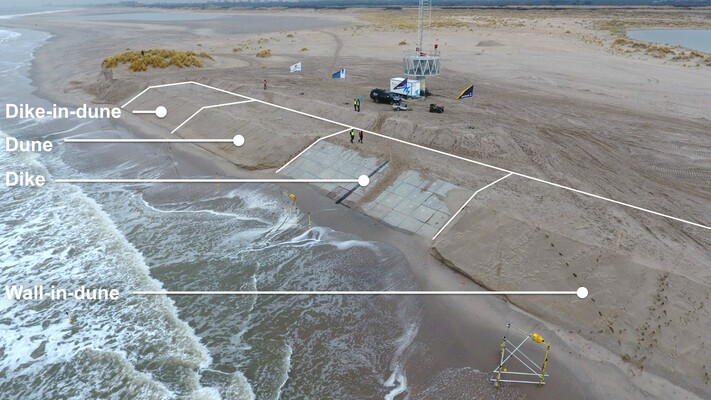D.W. Poppema1*, R.G.C. Rosman1,2 , S. de Vries1, S. Pluis3, R.T. McCall4, and A. Antonini1
1 Delft University of Technology, The Netherlands; 2 Boskalis, The Netherlands; 3 Rijkswaterstaat, The Netherlands; 4 Deltares, The Netherlands
* Corresponding author: d.w.poppema@tudelft.nl
Introduction
Hybrid flood defences, which combine sandy dunes with hard structures, are increasingly used in coastal flood protection. This combination allows to harness the opportunities sandy dunes offer in terms of nature, recreation and their potential to grow with sea level rise, while simultaneously benefitting from the reliable erosion resistance provided by traditional hard structures (stones, concrete elements, etc). By combining hard and soft elements, the stability of these hybrid flood defences becomes a function of the complex interplay between hard and soft, i.e. between dune morphology, wave action and structural stability. These interactions, though poorly understood, are essential to properly design new hybrid dunes or evaluate the safety of existing ones. We conducted the Hybrid Dune field experiment to measure the hydrodynamics and dune erosion at hybrid flood defences during storms. This work forms part of the NWO project Future FRMtech, with the experiment largely funded by Rijkswaterstaat. In this contribution, we will present the experimental setup, instrumentation and first results.
Objective and Methods
The Hybrid Dune experiment aims to better understand the erosion of hybrid dunes during storms, caused by the interplay between sandy dunes and hard structures. In a large field experiment, an artificial life-size hybrid dune was constructed just above the highwater line, to observe its response during storms. Methodologically, this resembles the RealDune experiment of Van Wiechen et al. (2024). The experiment took place at the Sand Motor in the winter of 2024/2025. The test dune contained four cross sections: 1) a classical sand dune section as baseline; 2) a dike section with a concrete revetment; 3) a hybrid dike-in-dune section, with the hard revetment covered by sand and 4) a dune with a vertical sea wall under the dune.
An extensive measurement array recorded water levels, waves, current velocities, sediment concentration, wave pressure at the hard structure and morphological evolution of the dune and foreshore. Hereto, the setup included 2 offshore ADCP’s; 5 ADV’s with each 2 OBS sensors in front of the cross sections, 12 pressure transducers in the intertidal zone and 30 on the hard-soft interface, 4 lidar scanners and 6 GoPro’s. In addition, topography was surveyed using a handheld GPS and a lidar drone.
Results
The experiment has resulted in a unique dataset with simultaneous high-resolution observations of hydrodynamics, sediment transport, dune- and foreshore morphology, wave runup and wave load on the structures. This will enable quantitative analysis of the morphological response to hydrodynamic drivers and hybrid dune configuration. Moreover, these observations can be used to include hybrid dunes in numerical dune erosion models.
Strong erosion occurred at the tested hybrid dune, caused by five storms during the measurement period, with peak water levels up to +2.1 m NAP. At the dike-in-dune, the initially-covered revetment (concrete tiles) was already uncovered by the first storm. The subsequent storms exposed more of the revetment, allowing the revetment to interact with the waves and sand transport. Sand eroded from underneath the revetment of section 1 and 3, causing them to gradually collapse from the sides. Nonetheless, no scour occurred in front of the concrete revetment. Likewise, scour remained absent in front of the wall-in-dune. Moreover, morphological differences between the different cross sections appeared to be limited. Seemingly, the beach response in front of the hybrid dune was principally governed by the large-scale sediment supply, beach elevation and hydrodynamic conditions, rather than the hard-soft interactions at the hybrid dune.

The test setup at the Sand Motor. Just after construction, with the concrete tiles of the dike section visible and the hard elements of the dike-in-dune and wall-in-dune still hidden under the sand.
References
Van Wiechen, P.P.J., Mieras, R., Tissier, M.F.S., & De Vries, S. (2024). Coastal dune erosion and slumping processes in the swash‐dune collision regime based on field measurements. Journal of Geophysical Research: Earth Surface, 129(10), e2024JF007711.


